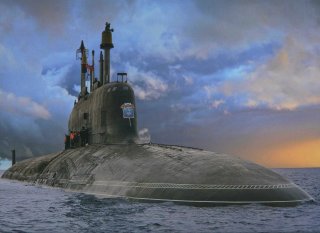The Russian Navy Is Adding More Deadly Nuclear Submarines
Navy Commander-in-Chief Admiral Nikolai Yevmenov said in an interview with the Defense Ministry's newspaper Krasnaya Zverzda that by the end of this year three nuclear-powered submarines including the Project Borei-A strategic underwater cruiser Knyaz Oleg and the Project Yasen-M submarines Kazan and Novosibirsk will enter service with the Russian Navy.
The Russian Navy maintains one of the largest submarine fleets in the world, but many are older boats that date back to the Cold War. Its force of eleven nuclear-powered ballistic missile submarines (SSBNs) has been considered integral to its strategic deterrent. Despite budget issues that have continued to plague Russia, it has pushed forward with its efforts to update its antiquated submarine fleet with newer boats
Navy Commander-in-Chief Admiral Nikolai Yevmenov said in an interview with the Defense Ministry's newspaper Krasnaya Zverzda that by the end of this year three nuclear-powered submarines including the Project Borei-A strategic underwater cruiser Knyaz Oleg and the Project Yasen-M submarines Kazan and Novosibirsk will enter service with the Russian Navy. According to Tass, all three of the boats are being built at the Sevmash Shipyard.
The Borei-A (Improved Project 955A) underwater cruiser Knyaz Oleg is the first serial-produced fourth-generation submarine and she was floated out on July 16 last year and is set to undergo sea trails before entering service with the Russian Pacific Fleet by the end of next year. While the first serial-produced boat of the class, it is the second to be completed. Last year the lead sub Knyaz Vladimir was handed off to the Northern Fleet, which has begun a gradual process of phasing out its older Delta and Typhoon-class boats.
The Boerei-A is twice as large as its Typhoon-class predecessor and marginally faster. More importantly, it is capable of fielding a much more powerful payload, which is why it will become the basis of Russia's seaborne strategic nuclear force. The submarine can carry sixteen RSM-56 Bulava intercontinental ballistic missiles (ICMB) – a submarine-launched derivative of the Topol-M – as their basic armament.
The Project Yasen-M submarines Kazan and Novosibirsk are set to be part of a new line of nuclear-powered cruise missile submarines that were designed to phase out Russia's aging, Soviet-era attack submarines.
The original Yasen boat, Severodvinsk, was laid down in 1993, but construction work sputtered in the years following the collapse of the Soviet Union. Due to a number of cyclical delays and budget deficits, the submarine was only launched in 2010. The class was upgraded/updated under the Yasen-M designation. The new revision is reported to be stealthier, possibly utilizing low magnetic steel for a reduced magnetic signature and the latest nuclear reactor technology for reduced overall acoustics.
The Yasen-M submarines carry Kalibr-PL and Oniks cruise missiles as their primary strike weapons. The submarines will also reportedly support the new 3M22 Tsirkon winged anti-ship hypersonic cruise missile, which is reportedly capable of hitting targets at a speed of over eight Mach or around 9800 kilometers per hour. In addition, the Yasen-M class retains the same, standard ten 533mm torpedo tubes of the original Yasen line.
Six additional Yansen-M submarines are also in varying stages of construction, with the next three of those: Krasnoyarsk, Arkhangelsk, and Perm slated to be launched this year.
Peter Suciu is a Michigan-based writer who has contributed to more than four dozen magazines, newspapers and websites. He regularly writes about military small arms, and is the author of several books on military headgear including A Gallery of Military Headdress, which is available on Amazon.com.

